Pronunciation:
(ka-MEL-oh-POR-duh-lis)Abbreviation:
CamGenitive:
CamelopardalisRight Ascension:
6 hoursDeclination:
70 degreesArea in Square Degrees:
757Crosses Meridian:
9 PM, February 1Visible Between Latitudes:
90 and -10 degreesThe constellation Camelopardalis, the giraffe, can be seen most of the year in the northern hemisphere. It is visible at latitudes north of -10 degrees. It is a fairly large constellation that occupies a total area of 757 square degrees. This makes it the 18th largest constellation in the night sky. It is bordered by the constellations Auriga, Cassiopeia, Cepheus, Draco, Lynx, Perseus, Ursa Major, and Ursa Minor. Camelopardalis is a circumpolar constellation which means it is visible all night as it rotates around the north celestial pole. It contains a star formation known as Kemble’s Cascade. This asterism forms a cascade of about 20 dim stars spread out in a straight line.
There are no myths associated with Camelopardalis. The ancient Greeks thought that this region of the sky was empty. Camelopardalis is one of 12 constellations named by the Dutch astronomer Petrus Plancius based on observations by Dutch navigators. Plancius included it on his celestial globe and a year later, in 1624, it was featured in a star atlas created by German astronomer Jakob Bartsch. This constellation was first observed to look like a camel. Bartsch originally described it as the animal Rebecca rode to marry Isaac in the Bible. The name was eventually changed to camelopardalis, which is Latin for giraffe. When dark conditions allow most of the stars to be seen, the constellation does resemble a giraffe.
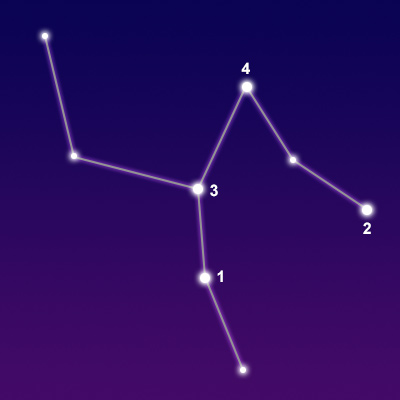
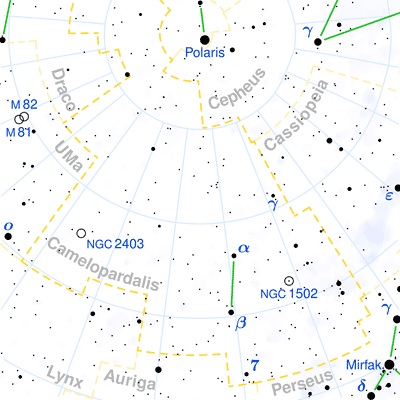
© Torsten Bronger CC BY-SA 3.0
2
3
4
CS Camelopardalis
Alpha Camelopardalis
Gamma Camelopardalis
N/A
N/A
N/A
Binary Star System
Blue Supergiant Star
White Subgiant Star
4.21
4.29
4.59
Camelopardalis is an extremely faint constellation with no stars brighter than magnitude 4. The brightest star in the constellation is Beta Camelopardalis with a visual magnitude of only 4.02. It is a yellow supergiant star located about 1,000 light years from Earth. The second brightest star is known as CS Camelopardalis. It is a binary star system with a combined magnitude of 4.21. It lies approximately 3,000 light years away. The third brightest star is Alpha Camelopardalis with a magnitude of only 4.29. It is a blue supergiant star located about 6,000 light years from Earth.
Camelopardalis contains no Messier objects but it does contain a few notable deep-sky objects. NGC 2403 is an intermediate spiral galaxy that contains several prominent nebulas. NGC 1502 is an open star cluster located at the end of the formation known as Kemble’s Cascade. It contains about 45 stars. NGC 1569 is a dwarf irregular galaxy that contains two visible star clusters. IC 342 is an intermediate spiral galaxy that appears face-on to our line of sight. Its is also called The Hidden Galaxy because its location in dusty areas near the galactic equator makes it difficult to observe. These objects are extremely dim and can only be seen in large telescopes.
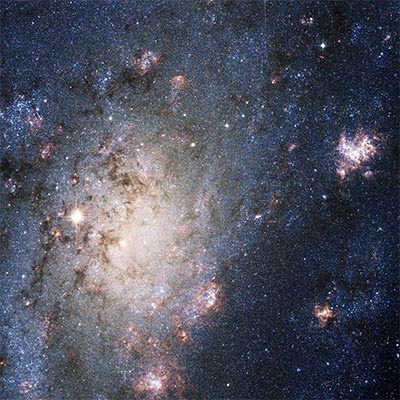
the Hubble Space Telescope
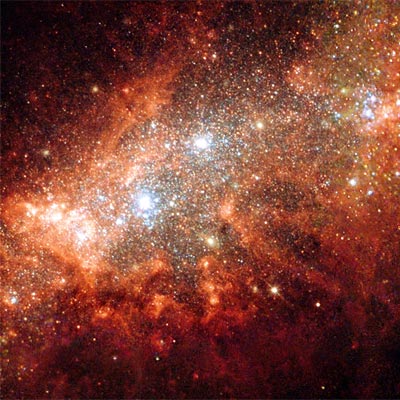
seen by the Hubble Space Telescope
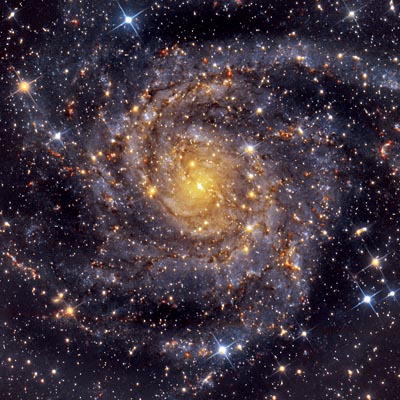
© W4sm astro / CC BY 4.0



